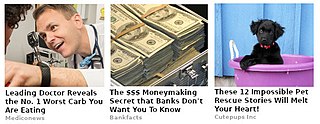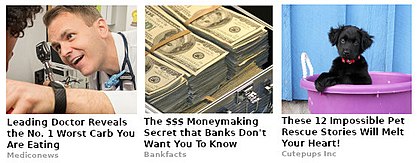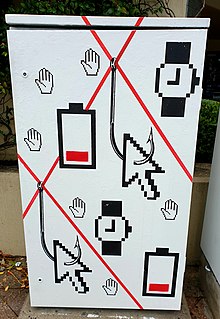
Media manipulation refers to orchestrated campaigns in which actors exploit the distinctive features of broadcasting mass communications or digital media platforms to mislead, misinform, or create a narrative that advance their interests and agendas.
Google AdSense is a program run by Google through which website publishers in the Google Network of content sites serve text, images, video, or interactive media advertisements that are targeted to the site content and audience. These advertisements are administered, sorted, and maintained by Google. They can generate revenue on either a per-click or per-impression basis. Google beta-tested a cost-per-action service, but discontinued it in October 2008 in favor of a DoubleClick offering. In Q1 2014, Google earned US$3.4 billion, or 22% of total revenue, through Google AdSense. AdSense is a participant in the AdChoices program, so AdSense ads typically include the triangle-shaped AdChoices icon. This program also operates on HTTP cookies. In 2021, over 38.3 million websites use AdSense.
Online advertising, also known as online marketing, Internet advertising, digital advertising or web advertising, is a form of marketing and advertising that uses the Internet to promote products and services to audiences and platform users. Online advertising includes email marketing, search engine marketing (SEM), social media marketing, many types of display advertising, and mobile advertising. Advertisements are increasingly being delivered via automated software systems operating across multiple websites, media services and platforms, known as programmatic advertising.
Social network advertising, also known as social media targeting, is a group of terms used to describe forms of online advertising and digital marketing focusing on social networking services. A significant aspect of this type of advertising is that advertisers can take advantage of users' demographic information, psychographics, and other data points to target their ads.
BuzzFeed, Inc. is an American Internet media, news and entertainment company with a focus on digital media. Based in New York City, BuzzFeed was founded in 2006 by Jonah Peretti and John S. Johnson III to focus on tracking viral content. Kenneth Lerer, co-founder and chairman of The Huffington Post, started as a co-founder and investor in BuzzFeed and is now the executive chairman.

Upworthy is a left leaning storytelling website with a focus on positive aspects.
Native advertising, also called sponsored content, partner content, and branded journalism, is a type of paid advertising that appears in the style and format of the content near the advertisement's placement. It manifests as a post, image, video, article or editorial piece of content. In some cases it functions like an advertorial. The word native refers to this coherence of the content with the other media that appear on the platform.
Dylan Matthews is an American journalist. He is currently a correspondent for Vox, an online media venture.
ClickHole is a satirical website that parodies clickbait websites such as BuzzFeed and Upworthy. It was launched on June 12, 2014, in conjunction with The Onion's decision to stop its print edition and shift its focus exclusively to the internet. According to ClickHole's senior editor, Jermaine Affonso, the website is "The Onion's response to click-bait content" and serves as "a parody of online media". Critics noted that, on a deeper level, ClickHole illustrates the shallow nature of social media content and media sites' desperation to share such content.

A Plus is a digital media company based in New York City. The company produces original written, social, and video content, with a focus on positive journalism. The company states that it "strive[s] to deliver positive journalism to readers, with the intention of making a meaningful difference in the world by highlighting our common humanity, promoting personal growth, and inspiring social change."
In journalism, a hot take is a "piece of deliberately provocative commentary that is based almost entirely on shallow moralizing" in response to a news story, "usually written on tight deadlines with little research or reporting, and even less thought".
Fake news websites are websites on the Internet that deliberately publish fake news—hoaxes, propaganda, and disinformation purporting to be real news—often using social media to drive web traffic and amplify their effect. Unlike news satire, fake news websites deliberately seek to be perceived as legitimate and taken at face value, often for financial or political gain. Such sites have promoted political falsehoods in India, Germany, Indonesia and the Philippines, Sweden, Mexico, Myanmar, and the United States. Many sites originate in, or are promoted by, Russia, or North Macedonia among others. Some media analysts have seen them as a threat to democracy. In 2016, the European Parliament's Committee on Foreign Affairs passed a resolution warning that the Russian government was using "pseudo-news agencies" and Internet trolls as disinformation propaganda to weaken confidence in democratic values.
Fake news websites target United States audiences by using disinformation to create or inflame controversial topics such as the 2016 election. Most fake news websites target readers by impersonating or pretending to be real news organizations, which can lead to legitimate news organizations further spreading their message. Most notable in the media are the many websites that made completely false claims about political candidates such as Hillary Clinton and Donald Trump, as part of a larger campaign to gain viewers and ad revenue or spread disinformation. Additionally, satire websites have received criticism for not properly notifying readers that they are publishing false or satirical content, since many readers have been duped by seemingly legitimate articles.
World News Daily Report (WNDR) was a satirical fake news website purporting to be an American Jewish Zionist newspaper based in Tel Aviv and dedicated to covering biblical archeology news and other mysteries around the globe.
Taboola is a public advertising company headquartered in New York City. It provides "content recommendation" sponsored links to advertising partners.

Occupy Democrats is an American left-wing media outlet built around a Facebook page and corresponding website. Established in 2012, it publishes false information, hyperpartisan content, and clickbait. Posts originating from the Occupy Democrats Facebook page are among the most widely shared political content on Facebook.

A chumbox is a form of online advertising that uses a grid of thumbnails and captions to drive traffic to other sites and webpages. This form of advertising is often associated with low quality clickbait links and articles. The term derives from the fishing practice of "chumming", the use of fish meat as a lure for fish.

Bored Panda is a Lithuanian website that publishes articles about "entertaining and amusing news". The majority of its articles are repackaged user-generated content from social media platforms such as Reddit, Instagram and Twitter. It was founded in 2009 by Tomas Banišauskas, who was then a business administration student at Vilnius University.
Peter Lennon Koechley is an American writer and internet entrepreneur. He was the managing editor of The Onion and co-founded Upworthy.
Rage-baiting or rage-farming is internet slang that refers to a manipulative tactic to elicit outrage with the goal of increasing internet traffic, online engagement, revenue and support. Rage baiting or farming can be used as a tool to increase engagement, attract subscribers, followers, and supporters, which can be financially lucrative. Rage baiting and rage farming manipulates users to respond in kind to offensive, inflammatory headlines, memes, tropes, or comments.







